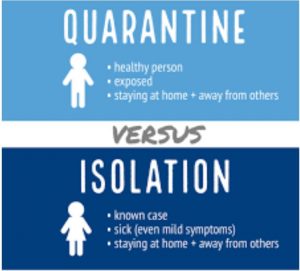
- Isolation and quarantine are public health measures used to stop or limit the spread of disease.
- These measures are used to protect the public by preventing exposure to infected persons or to persons who may be infected.
- Isolation and quarantine are used to care for the public by inhibiting contact with infected individuals or to individuals who can be diseased.
- However, there are some major differences between them.

10+ Major Differences Between Isolation and Quarantine:
| Isolation | Quarantine |
| Isolation is the separation of infected persons with communicable disease from others in such places/conditions so as to prevent/limit transmission to those susceptible. | Quarantine is the restriction of activities of apparently healthy persons who have been exposed to communicable disease during its period of communicability. |
| In simple words, isolation separates sick/ill people infected with contagious disease from those who are healthy/not sick. | In simple words, quarantine separates and restricts the movement of well people who were exposed to a contagious disease to see if they become sick. |
| It applies to person who are known to be ill with a contagious disease. | It applies to those who have been exposed to a contagious disease but who may or may not become ill. |
| Isolation is done to those who are already infected/diseased. | Quarantine is done to those who are apparently healthy. |
| These people are certainly exposed to the disease. | These people may or may not have been exposed to the disease. |
| E.g.: Hospitals isolate patients with infectious tuberculosis. | E.g.: Apparently healthy person travelling from COVID-19 (corona virus disease) affected countries are quarantined for 14 days incubation period. |
| Isolation is what you do for people who are sick. | Quarantine means you recognize that you have been exposed. |
| The person should be kept in isolation until the point of full recovery from the disease OR up to the period in which disease is considered contagious. | The person should be kept in quarantine up to the incubation period of the disease. If any symptoms of disease are seen within the incubation period, he/she should be then kept in isolation until full recovery. |
| Isolation is mostly preferred in presence or continuous observation of the health worker. | Quarantine can be done in home or health care setting with/without continuous observation of the health worker. |
| Isolated persons must be provided with good medical care and health check-up. Thus, it usually occurs in hospital site. | Health condition of a quarantine person should be continuously observed and monitored. He/she should undergo investigative testing. |
| People in isolation get care for their illness, with safety measures put into place to protect clinicians. E.g. wearing protective outfits etc. | Persons in quarantine are moved apart from the person who has not been exposed to illness or disease. |
| Isolation is effective for all setting to prevent the transmission of disease. | Quarantine is a significant defense for limited resource setting, especially for developing countries.
|
References and For More Information:
https://www.cdc.gov/quarantine/index.html
https://www.necn.com/multimedia/isolation-vs-quarantine-vs-self-quarantine/2248619/
https://www.ncbi.nlm.nih.gov/books/NBK92450/
https://www.cdc.gov/quarantine/quarantineisolation.html
https://www.who.int/trade/distance_learning/gpgh/gpgh8/en/index7.html
http://www.masslocalinstitute.info/IsolationQuarantine/IsolationQuarantine_print.html
https://www.ncbi.nlm.nih.gov/books/NBK92450/
https://www.diffen.com/difference/Isolation_vs_Quarantine
https://theconversation.com/quarantine-works-against-ebola-but-over-use-risks-disaster-32112
https://biotech.law.lsu.edu/cases/pp/naccho-quarantine.pdf
https://www.cdc.gov/sars/quarantine/fs-isolation.html
https://www.ncbi.nlm.nih.gov/pmc/articles/PMC6001516/